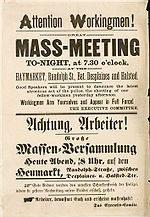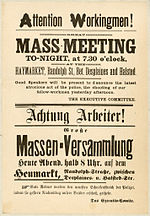A | B | C | D | E | F | G | H | CH | I | J | K | L | M | N | O | P | Q | R | S | T | U | V | W | X | Y | Z | 0 | 1 | 2 | 3 | 4 | 5 | 6 | 7 | 8 | 9
| Haymarket affair | |||
|---|---|---|---|
| Part of the Great Upheaval | |||
 This 1886 engraving was the most widely reproduced image of the Haymarket massacre. It shows Methodist pastor Samuel Fielden speaking, the bomb exploding, and the riot beginning simultaneously; in reality, Fielden had finished speaking before the explosion.[1] | |||
| Date | May 4, 1886 | ||
| Location | 41°53′5.6″N 87°38′38.9″W / 41.884889°N 87.644139°W | ||
| Goals | Eight-hour work day | ||
| Methods |
| ||
| Parties | |||
| Lead figures | |||
Carter Harrison Sr. | |||
| Casualties and losses | |||
| |||
The Haymarket affair, also known as the Haymarket massacre, the Haymarket riot, the Haymarket Square riot, or the Haymarket Incident, was the aftermath of a bombing that took place at a labor demonstration on May 4, 1886, at Haymarket Square in Chicago, Illinois, United States.[2] The rally began peacefully in support of workers striking for an eight-hour work day, the day after the events at the McCormick Harvesting Machine Company, during which one person was killed and many workers injured.[3] An unknown person threw a dynamite bomb at the police as they acted to disperse the meeting, and the bomb blast and ensuing retaliatory gunfire by the police caused the deaths of seven police officers and at least four civilians; dozens of others were wounded.[3]
Eight anarchists were charged with the bombing. In the internationally publicized legal proceedings against the accused, the eight were convicted of conspiracy.
The Haymarket affair is generally considered significant as the origin of International Workers' Day held on May 1,[4][5] and it was also the climax of the social unrest among the working class in America known as the Great Upheaval.
The evidence put forward in the court trial was that one of the defendants may have built the bomb, but none of those on trial had thrown it, and only two of the eight were at the Haymarket at the time.[6][7][8][9] Seven were sentenced to death and one to a term of 15 years in prison. Illinois Governor Richard J. Oglesby commuted two of the sentences to terms of life in prison; another died by suicide in jail before his scheduled execution. The other four were hanged on November 11, 1887.[3] In 1893, Illinois Governor John Peter Altgeld pardoned the remaining defendants and criticized the trial.[10]
The site of the incident was designated a Chicago landmark in 1992,[11] and a sculpture was dedicated there in 2004. In addition, the Haymarket Martyrs' Monument was designated a National Historic Landmark in 1997 at the defendants' burial site in Forest Park.[12]
Background
Following the Civil War, particularly following the Long Depression, there was a rapid expansion of industrial production in the United States. Chicago was a major industrial center and tens of thousands of German and Bohemian immigrants were employed at about $1.50 a day. American workers worked on average slightly over 60 hours, during a six-day work week.[13] The city became a center for many attempts to organize labor's demands for better working conditions.[14] Employers responded with anti-union measures, such as firing and blacklisting union members, locking out workers, recruiting strikebreakers; employing spies, thugs, and private security forces and exacerbating ethnic tensions in order to divide the workers.[15] Business interests were supported by mainstream newspapers, and were opposed by the labor and immigrant press.[16]
During the economic slowdown between 1882 and 1886, socialist and anarchist organizations were active. Membership of the Knights of Labor, which rejected socialism and radicalism but supported the eight-hour work day, grew from 70,000 in 1884 to over 700,000 by 1886.[17] In Chicago, the anarchist movement of several thousand, mostly immigrant, workers centered about the German-language newspaper Arbeiter-Zeitung ("Workers' Newspaper"), edited by August Spies. Other anarchists operated a militant revolutionary force with an armed section that was equipped with explosives. Its revolutionary strategy centered around the belief that successful operations against the police and the seizure of major industrial centers would lead to massive public support by workers, start a revolution, destroy capitalism, and establish a socialist economy.[18]
May Day parade and strikes
In October 1884, a convention held by the Federation of Organized Trades and Labor Unions unanimously set May 1, 1886, as the date by which the eight-hour work day would become standard.[19] As the chosen date approached, U.S. labor unions prepared for a general strike in support of the eight-hour day.[20]
On Saturday, May 1, thousands of workers who went on strike and attended rallies that were held throughout the United States sang from the anthem, Eight Hour. The chorus of the song reflected the ideology of the Great Upheaval, "Eight Hours for work. Eight hours for rest. Eight hours for what we will."[21] Estimates of the number of striking workers across the U.S. range from 300,000[22] to half a million.[23] In New York City, the number of demonstrators was estimated at 10,000.[24] and in Detroit at 11,000.[25] In Milwaukee, some 10,000 workers turned out.[25] In Chicago, the movement's center, an estimated 30,000 to 40,000 workers had gone on strike[22] and there were perhaps twice as many people out on the streets participating in various demonstrations and marches,[26][27] as, for example, a march by 10,000 men employed in the Chicago lumber yards.[23] Though participants in these events added up to 80,000, it is disputed whether there was a march of that number down Michigan Avenue led by anarchist Albert Parsons, founder of the International Working People's Association , his wife and fellow organizer Lucy, and their children.[22][28]
Speaking to a rally outside the West Side, Chicago, McCormick reaper plant on May 3, August Spies advised the striking workers to "hold together, to stand by their union, or they would not succeed".[29] Well-planned and coordinated, the general strike to this point had remained largely non-violent. When the end-of-the-workday bell sounded, however, a group of workers surged to the gates to confront strikebreakers. Spies called for calm, but the police fired on the crowd. Two McCormick workers were killed; some newspaper accounts said there were six fatalities.[30] Spies later testified, "I was very indignant. I knew from experience of the past that this butchering of people was done for the express purpose of defeating the eight-hour movement."[29]
Outraged by this act of police violence, local anarchists quickly printed and distributed fliers calling for a rally the following day at Haymarket Square (also called the Haymarket), which was then a bustling commercial center near the corner of Randolph Street and Desplaines Street. Printed in German and English, the fliers stated that the police had murdered the strikers on behalf of business interests and urged workers to seek justice. The first batch of fliers contain the words Workingmen Arm Yourselves and Appear in Full Force! When Spies saw the line, he said he would not speak at the rally unless the words were removed from the flier. All but a few hundred of the fliers were destroyed, and new fliers were printed without the offending words;[31] more than 20,000 copies were distributed.[32]
Rally at Haymarket Square
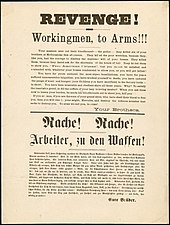
The rally began peacefully under a light rain on the evening of May 4. August Spies, Albert Parsons, and the Rev. Samuel Fielden spoke to a crowd estimated variously at between 600 and 3,000[33] while standing in an open wagon adjacent to the square on Des Plaines Street.[11] A large number of on-duty police officers watched from nearby.[11]
Paul Avrich, a historian specializing in the study of anarchism, quotes Spies as saying:
There seems to prevail the opinion in some quarters that this meeting has been called for the purpose of inaugurating a riot, hence these warlike preparations on the part of so-called 'law and order.' However, let me tell you at the beginning that this meeting has not been called for any such purpose. The object of this meeting is to explain the general situation of the eight-hour movement and to throw light upon various incidents in connection with it.[34]
Following Spies' speech, the crowd was addressed by Parsons, the Alabama-born editor of the radical English-language weekly The Alarm.[35] The crowd was so calm that Mayor Carter Harrison Sr., who had stopped by to watch, walked home early. Parsons spoke for almost an hour before standing down in favor of the last speaker of the evening, the English-born socialist, anarchist, and labor activist Methodist pastor, Rev. Samuel Fielden, who delivered a brief ten-minute address. Many of the crowd had already left as the weather was deteriorating.[35]
A New York Times article, with the dateline May 4, and headlined "Rioting and Bloodshed in the Streets of Chicago ... Twelve Policemen Dead or Dying", reported that Fielden spoke for 20 minutes, alleging that his words grew "wilder and more violent as he proceeded".[36] Another New York Times article, headlined "Anarchy's Red Hand" and dated May 6, opens with: "The villainous teachings of the Anarchists bore bloody fruit in Chicago tonight and before daylight at least a dozen stalwart men will have laid down their lives as a tribute to the doctrine of Herr Johann Most." (Most was a German-American anarchy-theorist and leader, who was not in Chicago). The article referred to the strikers as a "mob" and used quotation marks around the term "workingmen".[37]
Bombing and gunfire
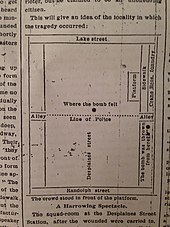
At about 10:30 pm, just as Fielden was finishing his speech, police arrived en masse, marching in formation towards the speakers' wagon, and ordered the rally to disperse.[38] Fielden insisted that the meeting was peaceful. Police Inspector John Bonfield proclaimed:
I command you in the name of the law to desist and you to disperse.[36][39]
A home-made fragmentation bomb[40][41] was thrown into the path of the advancing police, where it exploded, killing policeman Mathias J. Degan[42] and severely wounding many of the other policemen.[36][43]
Witnesses maintained that immediately after the bomb blast there was an exchange of gunshots between police and demonstrators.[44] It is unclear who fired first.[45] Historian Paul Avrich maintains that "nearly all sources agree that it was the police who opened fire", reloaded and then fired again, killing at least four and wounding as many as 70 people.[46] In less than five minutes the square was empty except for the casualties. According to the May 4 New York Times, demonstrators began firing at the police, who then returned fire.[36] In his report on the incident, Inspector Bonfield wrote that he "gave the order to cease firing, fearing that some of our men, in the darkness might fire into each other".[47] An anonymous police official told the Chicago Tribune, "A very large number of the police were wounded by each other's revolvers. ... It was every man for himself, and while some got two or three squares away, the rest emptied their revolvers, mainly into each other."[48]
In all, seven policemen and at least four workers were killed. Avrich said that most of the police deaths were from police gunfire.[49] Historian Timothy Messer-Kruse argues that, although it is impossible to rule out lethal friendly fire, several policemen were probably shot by armed protesters.[50] Another policeman died two years after the incident from complications related to injuries received that day.[51] Police captain Michael Schaack later wrote that the number of wounded workers was "largely in excess of that on the side of the police".[52] The Chicago Herald described a scene of "wild carnage" and estimated at least fifty dead or wounded civilians lay in the streets.[53] It is unclear how many civilians were wounded since many were afraid to seek medical attention, fearing arrest. They found aid where they could.[36][54][55]
Aftermath and red scare

A harsh anti-union clampdown followed the Haymarket incident and the Great Upheaval subsided. Employers regained control of their workers and traditional workdays were restored to ten or more hours a day.[56] There was a massive outpouring of community and business support for the police and many thousands of dollars were donated to funds for their medical care and to assist their efforts. The entire labor and immigrant community, particularly Germans and Bohemians, came under suspicion. Police raids were carried out on homes and offices of suspected anarchists. Dozens of suspects, many only remotely related to the Haymarket Affair, were arrested. Ignoring legal requirements such as for search warrants, Chicago police squads subjected the labor activists of Chicago to an eight-week shakedown, ransacking their meeting halls and places of business. The emphasis was on the speakers at the Haymarket rally and the newspaper Arbeiter-Zeitung. A small group of anarchists were declared to have been engaged in making bombs on the same day as the incident, including round ones like the one used in Haymarket Square.[57]
Newspaper reports declared that anarchist agitators were to blame for the "riot", a view adopted by an alarmed public. As time passed, press reports and illustrations of the incident became more elaborate. Coverage was national, then international. Among property owners, the press, and other elements of society, a consensus developed that suppression of anarchist agitation was necessary while for their part, union organizations such as The Knights of Labor and craft unions were quick to disassociate themselves from the anarchist movement and to repudiate violent tactics as self-defeating.[58] Many workers, on the other hand, believed that industry-hired men of the Pinkerton agency were responsible because of the agency's tactic of secretly infiltrating labor groups and its sometimes violent methods of strike breaking.[59]
Legal proceedings
Investigation

The police assumed that an anarchist had thrown the bomb as part of a planned conspiracy; their problem was how to prove it. On the morning of May 5, they raided the offices of the Arbeiter-Zeitung, arresting its editor August Spies and his brother, who was not charged. Also arrested were editorial assistant Michael Schwab and Adolph Fischer, a typesetter. A search of the premises resulted in the discovery of the "Revenge Poster" and other evidence considered incriminating by the prosecution.[60]
On May 7, police searched the premises of Louis Lingg where they found a number of bombs and bomb-making materials.[61] Lingg's landlord William Seliger was also arrested, but cooperated with police, identified Lingg as a bomb-maker, and was not charged.[62] An associate of Spies, Balthazar Rau, suspected as the bomber, was traced to Omaha and brought back to Chicago. After interrogation, Rau offered to cooperate with police. He alleged that the defendants had experimented with dynamite bombs and accused them of having published what he said was a code word, "Ruhe" ("peace"), in the Arbeiter-Zeitung as a call to arms at Haymarket Square.[60][63]
Defendants
Rudolf Schnaubelt, the police's lead suspect as the bomb thrower, was arrested twice early on and released. By May 14, when it became apparent he had played a significant role in the event, he had fled the country.[60][64] William Seliger, who had turned state's evidence and testified for the prosecution, was freed by the state. On June 4, 1886, eight other suspects were indicted by the grand jury, and stood trial for being accessories to the murder of Degan.[65] Of these, only two had been present when the bomb exploded. Spies and Fielden had spoken at the peaceful rally and were stepping down from the speaker's wagon in compliance with police orders to disperse just before the bomb went off. Two others had been present at the beginning of the rally but had left and were at Zepf's Hall, an anarchist rendezvous, at the time of the explosion. They were Arbeiter-Zeitung typesetter Adolph Fischer, and the well-known activist Albert Parsons, who had spoken for an hour at the Haymarket rally before going to Zepf's. Parsons, who believed that the evidence against them all was weak, subsequently voluntarily turned himself in, in solidarity with the accused.[60] A third man, Spies's assistant editor Michael Schwab (who was the brother-in-law of Schnaubelt) was arrested, as he had been speaking at another rally at the time of the bombing; he was also later pardoned. Not directly tied to the Haymarket rally, but arrested for their militant radicalism were George Engel, who had been at home playing cards on that day, and Louis Lingg, the hot-headed bomb-maker denounced by his associate, Seliger. Another defendant who had not been present that day was Oscar Neebe, an American-born citizen of German descent who was associated with the Arbeiter-Zeitung and had attempted to revive it in the aftermath of the Haymarket riot.[66]
Of the eight defendants, five – Spies, Fischer, Engel, Lingg and Schwab – were immigrants born in Germany; a sixth, Neebe, was a U.S.-born citizen of German descent. The remaining two, Parsons and Fielden, born in the U.S. and England, respectively, were of British heritage.[64]
Trial
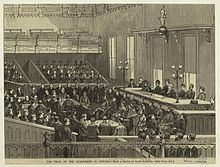
The trial, Illinois vs. August Spies et al., began on June 21, 1886, and went on until August 11. The trial was conducted in an atmosphere of extreme prejudice by both public and media toward the defendants.[67] It was presided over by Judge Joseph Gary, who displayed open hostility to the defendants, consistently ruled for the prosecution, and failed to maintain decorum. A motion to try the defendants separately was denied.[68] The defense counsel included Sigmund Zeisler and William Perkins Black. Selection of a jury was extraordinarily difficult, lasting three weeks, and nearly one thousand people called. All union members and anyone who expressed sympathy toward socialism were dismissed. In the end a jury of 12 was seated, most of whom confessed prejudice against the defendants. Despite their professions of prejudice Judge Gary seated those who declared that despite their prejudices they would acquit if the evidence supported it, refusing to dismiss for prejudice. Eventually the peremptory challenges of the defense were exhausted. Frustrated by the hundreds of jurors who were being dismissed, a bailiff was appointed who selected jurors rather than calling them at random. The bailiff proved prejudiced himself and selected jurors who seemed likely to convict based on their social position and attitudes toward the defendants.[68] The prosecution, led by Julius Grinnell, argued that, since the defendants had not actively discouraged the person who had thrown the bomb, they were therefore equally responsible as conspirators.[69] The jury heard the testimony of 118 people, including 54 members of the Chicago Police Department and the defendants Fielden, Schwab, Spies and Parsons. Albert Parsons's brother claimed there was evidence linking the Pinkertons to the bomb. This reflected a widespread belief among the strikers.[59]

Police investigators under Captain Michael Schaack had a lead fragment removed from a policeman's wounds chemically analyzed. They reported that the lead used in the casing matched the casings of bombs found in Lingg's home.[41] A metal nut and fragments of the casing taken from the wound also roughly matched bombs made by Lingg.[60] Schaack concluded, on the basis of interviews, that the anarchists had been experimenting for years with dynamite and other explosives, refining the design of their bombs before coming up with the effective one used at the Haymarket.[60]
At the last minute, when it was discovered that instructions for manslaughter had not been included in the submitted instructions, the jury was called back, and the instructions were given.[70]
Verdict and contemporary reactions

The jury returned guilty verdicts for all eight defendants. Before being sentenced, Neebe told the court that Schaack's officers were among the city's worst gangs, ransacking houses and stealing money and watches. Schaack laughed and Neebe retorted, "You need not laugh about it, Captain Schaack. You are one of them. You are an anarchist, as you understand it. You are all anarchists, in this sense of the word, I must say."[71] Judge Gary sentenced seven of the defendants to death by hanging and Neebe to 15 years in prison. The sentencing provoked outrage from labor and workers' movements and their supporters, resulting in protests around the world, and elevating the defendants to the status of martyrs, especially abroad. Portrayals of the anarchists as bloodthirsty foreign fanatics in the press along with the 1889 publication of Captain Schaack's sensational account, Anarchy and Anarchism, on the other hand, inspired widespread public fear and revulsion against the strikers and general anti-immigrant feeling, polarizing public opinion.[72]
In an article datelined May 4, entitled "Anarchy's Red Hand", The New York Times had described the incident as the "bloody fruit" of "the villainous teachings of the Anarchists".[73][74] The Chicago Times described the defendants as "arch counselors of riot, pillage, incendiarism and murder"; other reporters described them as "bloody brutes", "red ruffians", "dynamarchists", "bloody monsters", "cowards", "cutthroats", "thieves", "assassins", and "fiends".[75] The journalist George Frederic Parsons wrote a piece for The Atlantic Monthly in which he identified the fears of middle-class Americans concerning labor radicalism, and asserted that the workers had only themselves to blame for their troubles.[76] Edward Aveling remarked, "If these men are ultimately hanged, it will be the Chicago Tribune that has done it."[77] Schaack, who had led the investigation, was dismissed from the police force for allegedly having fabricated evidence in the case, but was reinstated in 1892.[78]
Appeals
The case was appealed in 1887 to the Supreme Court of Illinois,[79] then to the United States Supreme Court where the defendants were represented by John Randolph Tucker, Roger Atkinson Pryor, General Benjamin F. Butler and William P. Black. The petition for certiorari was denied.[80]
Commutations and suicide
After the appeals had been exhausted, Illinois Governor Richard James Oglesby commuted Fielden's and Schwab's sentences to life in prison on November 10, 1887. On the eve of his scheduled execution, Lingg died by suicide in his cell with a smuggled blasting cap which he reportedly held in his mouth like a cigar (the blast blew off half his face and he survived in agony for six hours).[81]
Executions
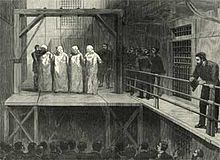
The next day (November 11, 1887) four defendants—Engel, Fischer, Parsons, and Spies—were taken to the gallows in white robes and hoods. They sang the Marseillaise, then the anthem of the international revolutionary movement. Family members including Lucy Parsons, who attempted to see them for the last time, were arrested and searched for bombs (none was found). According to witnesses, in the moments before the men were hanged, Spies shouted, "The time will come when our silence will be more powerful than the voices you strangle today."[82] In their last words, Engel and Fischer called out, "Hurrah for anarchism!" Parsons then requested to speak, but he was cut off when the signal was given to spring the trap door. Witnesses reported that the condemned men did not die immediately when they dropped, but strangled to death slowly, a sight which left the spectators visibly shaken.[82]
Identity of the bomber
Notwithstanding the convictions for conspiracy, no actual bomber was ever brought to trial, "and no lawyerly explanation could ever make a conspiracy trial without the main perpetrator seem completely legitimate."[83] Historians such as James Joll and Timothy Messer-Kruse say the evidence points to Rudolph Schnaubelt, brother-in-law of Schwab, as the likely perpetrator.[50]
Documents
An extensive collection of documents relating to the Haymarket Affair and the legal proceedings related to it, The Haymarket Affair Digital Collection, has been created by the Chicago Historical Society.[84]
Pardons and historical characterization

Among supporters of the labor movement in the United States and abroad and others, the trial was widely believed to have been unfair, and even a serious miscarriage of justice. Prominent people including novelist William Dean Howells, celebrated attorney Clarence Darrow,[85] poet and playwright Oscar Wilde, playwright George Bernard Shaw, and poet William Morris strongly condemned it. On June 26, 1893, Illinois governor John Peter Altgeld, the progressive governor of Illinois, himself a German immigrant, signed pardons for Fielden, Neebe, and Schwab,[86] calling them victims of "hysteria, packed juries, and a biased judge" and noting that the state "has never discovered who it was that threw the bomb which killed the policeman, and the evidence does not show any connection whatsoever between the defendants and the man who threw it".[87] Altgeld also faulted the city of Chicago for failing to hold Pinkerton guards responsible for repeated use of lethal violence against striking workers.[88] Altgeld's actions concerning labor were used to defeat his reelection.[89][90][91]
Soon after the trial, anarchist Dyer Lum wrote a history of the trial critical of the prosecution. In 1888, George McLean, and in 1889, police captain Michael Schack, wrote accounts from the opposite perspective.[92] Awaiting sentencing, each of the defendants wrote their own autobiographies (edited and published by Philip Foner in 1969), and later activist Lucy Parsons published a biography of her condemned husband Albert Parsons. Fifty years after the event, Henry David wrote a history, which preceded another scholarly treatment by Paul Avrich in 1984, and a "social history" of the era by Bruce C. Nelson in 1988. In 2006, labor historian James Green wrote a popular history.[92]
Christopher Thale writes in the Encyclopedia of Chicago that lacking credible evidence regarding the bombing, "...the prosecution focused on the writings and speeches of the defendants."[93] He further notes that the conspiracy charge was legally unprecedented, the judge was "partisan," and all the jurors admitted prejudice against the defendants. Historian Carl Smith writes, "The visceral feelings of fear and anger surrounding the trial ruled out anything but the pretense of justice right from the outset."[94] Smith notes that scholars have long considered the trial a "notorious" "miscarriage of justice".[95] In a review somewhat more critical of the defendants, historian Jon Teaford concludes that "he tragedy of Haymarket is the American justice system did not protect the damn fools who most needed that protection... It is the damn fools who talk too much and too wildly who are most in need of protection from the state."[92] Historian Timothy Messer-Kruse revisited the digitized trial transcript and argued that the proceedings were fair for their time, a challenge to the historical consensus that the trial was a travesty.[96]
Effects on the labor movement and May Day
Historian Nathan Fine points out that trade-union activities continued to show signs of growth and vitality, culminating later in 1886 with the establishment of the Labor Party of Chicago.[97]
Fine observes:
he fact is that despite police repression, newspaper incitement to hysteria, and organization of the possessing classes, which followed the throwing of the bomb on May 4, the Chicago wage earners only united their forces and stiffened their resistance. The conservative and radical central bodies – there were two each of the trade unions and two also of the Knights of Labor – the socialists and the anarchists, the single taxers and the reformers, the native born...and the foreign born Germans, Bohemians, and Scandinavians, all got together for the first time on the political field in the summer following the Haymarket Affair.... The Knights of Labor doubled its membership, reaching 40,000 in the fall of 1886. On Labor Day the number of Chicago workers in parade led the country.[97]
On the first anniversary of the event, May 4, 1887, the New-York Tribune published an interview with Senator Leland Stanford, in which he addressed the consensus that "the conflict between capital and labor is intensifying" and articulated the vision advocated by the Knights of Labor for an industrial system of worker-owned co-operatives, another among the strategies pursued to advance the conditions of laborers.[98] The interview was republished as a pamphlet to include the bill Stanford introduced in the Senate to foster co-operatives.[99]
Popular pressure continued for the establishment of the 8-hour day. At the convention of the American Federation of Labor (AFL) in 1888, the union decided to campaign for the shorter workday again. May 1, 1890, was agreed upon as the date on which workers would strike for an eight-hour workday.[100]
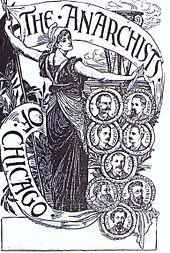
In 1889, AFL president Samuel Gompers wrote to the first congress of the Second International, which was meeting in Paris. He informed the world's socialists of the AFL's plans and proposed an international fight for a universal eight-hour workday.[101] In response to Gompers's letter, the Second International adopted a resolution calling for "a great international demonstration" on a single date so workers everywhere could demand the eight-hour workday. In light of the Americans' plan, the International adopted May 1, 1890, as the date for this demonstration.[102]
A secondary purpose behind the adoption of the resolution by the Second International was to honor the memory of the Haymarket martyrs and other workers who had been killed in association with the strikes on May 1, 1886. Historian Philip Foner writes "there is little doubt that everyone associated with the resolution passed by the Paris Congress knew of the May 1 demonstrations and strikes for the eight-hour day in 1886 in the United States ... and the events associated with the Haymarket tragedy."[102]
The first International Workers Day was a spectacular success. The front page of the New York World on May 2, 1890, was devoted to coverage of the event. Two of its headlines were "Parade of Jubilant Workingmen in All the Trade Centers of the Civilized World" and "Everywhere the Workmen Join in Demands for a Normal Day".[103] The Times of London listed two dozen European cities in which demonstrations had taken place, noting there had been rallies in Cuba, Peru and Chile.[104] Commemoration of May Day became an annual event the following year.
The association of May Day with the Haymarket martyrs has remained strong in Mexico. Mary Harris "Mother" Jones was in Mexico on May 1, 1921, and wrote of the "day of 'fiestas'" that marked "the killing of the workers in Chicago for demanding the eight-hour day".[105] In 1929, The New York Times referred to the May Day parade in Mexico City as "the annual demonstration glorifying the memory of those who were killed in Chicago in 1887".[106] The New York Times described the 1936 demonstration as a commemoration of "the death of the martyrs in Chicago".[107] In 1939, Oscar Neebe's grandson attended the May Day parade in Mexico City and was shown, as his host told him, "how the world shows respect to your grandfather".[108]
The influence of the Haymarket Affair was not limited to the celebration of May Day. Emma Goldman, the activist and political theorist, was attracted to anarchism after reading about the incident and the executions, which she later described as "the events that had inspired my spiritual birth and growth". She considered the Haymarket martyrs to be "the most decisive influence in my existence," and was powerfully moved by attending the famous socialist speaker Johanna Greie's speech on the subject, expressing that "at the end of Greie's speech I knew what I had surmised all along: the Chicago men were innocent."[109] Her associate, Alexander Berkman also described the Haymarket anarchists as "a potent and vital inspiration".[110] Others whose commitment to anarchism, or revolutionary socialism, crystallized as a result of the Haymarket Affair included Voltairine de Cleyre and "Big Bill" Haywood, a founding member of the Industrial Workers of the World.[110] Goldman wrote to historian Max Nettlau that the Haymarket Affair had awakened the social consciousness of "hundreds, perhaps thousands, of people".[111]
Suspected bombersedit
While admitting that none of the defendants was involved in the bombing, the prosecution made the argument that Lingg had built the bomb, and prosecution witnesses Harry Gilmer and Malvern Thompson tried to imply that the bomb-thrower was helped by Spies, Fischer and Schwab.[112][113] The defendants claimed they had no knowledge of the bomber at all.
Several activists, including Robert Reitzel, later hinted they knew who the bomber was.[114] Writers and other commentators have speculated about many possible suspects:
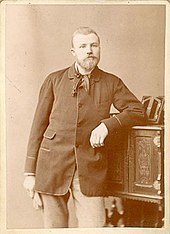
- Rudolph Schnaubelt (1863–1901) was an activist and the brother-in law of Michael Schwab. He was at the Haymarket when the bomb exploded. General Superintendent of the Chicago Police Department Frederick Ebersold issued a handwritten bulletin for his arrest for murder and inciting a riot on June 14, 1886.[115][116] Schnaubelt was indicted with the other defendants but fled the city and later the country before he could be brought to trial. He was the detectives' lead suspect, and state witness Gilmer testified he saw Schnaubelt throw the bomb, identifying him from a photograph in court.[117] Schnaubelt later sent two letters from London disclaiming all responsibility, writing, "If I had really thrown this bomb, surely I would have nothing to be ashamed of, but in truth I never once thought of it."[118] He is the most generally accepted and widely known suspect and figured as the bomb thrower in The Bomb, Frank Harris's 1908 fictionalization of the tragedy. Written from Schnaubelt's point of view, the story opens with him confessing on his deathbed. However, Harris's description was fictional and those who knew Schnaubelt vehemently criticized the book.[119]
- George Schwab was a German shoemaker who died in 1924. German anarchist Carl Nold claimed he learned Schwab was the bomber through correspondence with other activists, but no proof ever emerged. Historian Paul Avrich also suspected him but noted that while Schwab was in Chicago, he had only arrived days before. This contradicted statements by others that the bomber was a well-known figure in Chicago.[120][121]
- George Meng (b. around 1840) was a German anarchist and teamster who owned a small farm outside of Chicago where he had settled in 1883 after emigrating from Bavaria. Like Parsons and Spies, he was a delegate at the Pittsburgh Congress and a member of the IWPA. Meng's granddaughter, Adah Maurer, wrote Paul Avrich a letter in which she said that her mother, who was 15 at the time of the bombing, told her that her father was the bomber. Meng died some time before 1907 in a saloon fire. Based on his correspondence with Maurer, Avrich concluded that there was a "strong possibility" that the little-known Meng may have been the bomber.[122]
- An agent provocateur was suggested by some members of the anarchist movement. Albert Parsons believed the bomber was a member of the police or the Pinkertons trying to undermine the labor movement. However, this contradicts the statements of several activists who said the bomber was one of their own. For example, Lucy Parsons and Johann Most rejected this notion. Dyer Lum said it was "puerile" to ascribe "the Haymarket bomb to a Pinkerton".[123]
- A disgruntled worker was widely suspected. When Adolph Fischer was asked if he knew who threw the bomb, he answered, "I suppose it was some excited workingman." Oscar Neebe said it was a "crank".[124] Governor Altgeld speculated the bomb thrower might have been a disgruntled worker who was not associated with the defendants or the anarchist movement but had a personal grudge against the police. In his pardoning statement, Altgeld said the record of police brutality toward the workers had invited revenge adding, "Capt. Bonfield is the man who is really responsible for the deaths of the police officers."[125]
- Klemana Schuetz was identified as the bomber by Franz Mayhoff, a New York anarchist and fraudster, who claimed in an affidavit that Schuetz had once admitted throwing the Haymarket bomb. August Wagener, Mayhoff's attorney, sent a telegram from New York to defense attorney Captain William Black the day before the executions claiming knowledge of the bomber's identity. Black tried to delay the execution with this telegram, but Governor Oglesby refused. It was later learned that Schuetz was the primary witness against Mayhoff at his trial for insurance fraud, so Mayhoff's affidavit has never been regarded as credible by historians.[126]
- Reinold "Big" Krueger was killed by police either in the melee after the bombing or in a separate disturbance the next day and has been named as a suspect but there is no supporting evidence.[127][128]
- A mysterious outsider was reported by John Philip Deluse, a saloon keeper in Indianapolis who claimed he encountered a stranger in his saloon the day before the bombing. The man was carrying a satchel and on his way from New York to Chicago. According to Deluse, the stranger was interested in the labor situation in Chicago, repeatedly pointed to his satchel and said, "You will hear of some trouble there very soon."[129] Parsons used Deluse's testimony to suggest the bomb thrower was sent by eastern capitalists.[130] Nothing more was ever learned about Deluse's claim.
Burial and monumentedit

Lingg, Spies, Fischer, Engel, and Parsons were buried at the German Waldheim Cemetery (later merged with Forest Home Cemetery) in Forest Park, Illinois, a suburb of Chicago. Schwab and Neebe were also buried at Waldheim when they died, reuniting the "Martyrs". In 1893, the Haymarket Martyrs' Monument by sculptor Albert Weinert was raised at Waldheim. Over a century later, it was designated a National Historic Landmark by the United States Department of the Interior.
Throughout the 20th century, activists such as Emma Goldman chose to be buried near the Haymarket Martyrs' Monument graves.[131]
Zdroj:https://en.wikipedia.org?pojem=Haymarket_affair
>Text je dostupný pod licencí Creative Commons Uveďte autora – Zachovejte licenci, případně za dalších podmínek. Podrobnosti naleznete na stránce Podmínky užití.
Haymarket Riot (band)
Great Railroad Strike of 1877
File:HaymarketRiot-Harpers.jpg
Samuel Fielden
Chicago
Illinois
United States
Federation of Organized Trades and Labor Unions
Chicago Police Department
August Spies
Albert Parsons
Samuel Fielden
Carter Harrison Sr.
File:Chicago central map.png
Template:Campaignbox US Labor strikes
Template talk:Campaignbox US Labor strikes
Special:EditPage/Template:Campaignbox US Labor strikes
List of strikes
Template:Campaignbox US agricultural strikes
Template talk:Campaignbox US agricultural strikes
Special:EditPage/Template:Campaignbox US agricultural strikes
Thibodaux massacre
Cotton pickers' strike of 1891
Oxnard strike of 1903
Seattle Fishermen halibut strike of 1912
Grabow riot
Wheatland hop riot
1916–1917 northern Minnesota lumber strike
Hanapepe massacre
Cantaloupe strike of 1928
Imperial Valley lettuce strike of 1930
Santa Clara cannery strike
Vacaville tree pruners' strike
1933 Wisconsin milk strike
1933 Yakima Valley strike
California agricultural strikes of 1933
Santa Clara cherry strike of 1933
El Monte berry strike of 1933
Pacific Northwest lumber strike
Stockton cannery strike of 1937
Hawaiian sugar strike of 1946
Puget Sound fishermen's strike of 1949
Delano grape strike
Salad Bowl strike
1985–1987 Watsonville Cannery strike
2021 Frito-Lay strike
Template:Campaignbox Coal Wars
Template talk:Campaignbox Coal Wars
Special:EditPage/Template:Campaignbox Coal Wars
Coal Wars
Coal miners' strike of 1873
Morewood massacre
Coal Creek War
Bituminous coal miners' strike of 1894
Lattimer massacre
Illinois coal wars
Battle of Virden
Pana riot
Carterville Mine Riot
Anthracite coal strike of 1902
Carbon County Strike
Westmoreland County coal strike of 1910–1911
Paint Creek–Cabin Creek strike of 1912
Colorado Coalfield War
Ludlow Massacre
Colorado Coalfield War#The 10-Day War
Hartford coal mine riot
West Virginia coal wars
Battle of Matewan
Battle of Blair Mountain
1920 Alabama coal strike
UMW General coal strike (1922)
Herrin massacre
1927 Indiana bituminous strike
1927–1928 Colorado Coal Strike
Columbine Mine massacre
Harlan County War
Battle of Evarts
1974 UMW Bituminous coal strike
UMW Bituminous coal strike of 1977–1978
Pittston Coal strike
2021–2023 Warrior Met Coal strike
Template:Campaignbox general strikes
Template talk:Campaignbox general strikes
Special:EditPage/Template:Campaignbox general strikes
General strike
1835 Philadelphia general strike
1877 St. Louis general strike
Scranton general strike
International Workers' Day
1892 New Orleans general strike
1909 Swedish general strike
Philadelphia general strike (1910)
1918 Vancouver general strike
Seattle General Strike
Winnipeg general strike
Kapp Putsch#General Strike against the Coup
1934 West Coast waterfront strike
Minneapolis general strike of 1934
1946 Oakland general strike
1950 Austrian general strikes
Finnish general strike of 1956
1958 Paraguayan general strike
1971–72 Namibian contract workers strike
1973 Uruguayan general strike
1988 Spanish general strike
April 1992 Nepalese general strike
2007 Guinean general strike
2008 Egyptian general strike
2009 French Caribbean general strikes
2010 Spanish general strike
2012 European general strike
2016 Indian general strike
2017 Brazilian general strike
2017 Catalan general strike
2019 Catalan general strike
Template:Campaignbox US manufacturing strikes
Template talk:Campaignbox US manufacturing strikes
Special:EditPage/Template:Campaignbox US manufacturing strikes
Cigar makers' strike of 1877
1913 El Paso smelters' strike
1913 Studebaker strike
Bayonne refinery strikes of 1915–1916
Boston cigar makers' strike of 1919
Ybor City cigar makers' strike of 1931
Auto-Lite strike (1934)
Kohler strikes
Flint sit-down strike
1936 Akron rubber strike
Remington Rand strike of 1936–1937
Battle of the Overpass
Chrysler Auto Strike
Tool and die strike of 1939
1945–1946 General Motors strike
1948 Boeing strike
Kohler strikes
International Harvester strike of 1979–1980
1983 Pacific Coast Metal Trades Union strike
1987–1988 International Paper strike
1986–1987 John Deere strike
2007 General Motors strike
2008 Boeing machinists strike
2015 United Steel Workers Oil Refinery strike
2015 Kohler strike
2016 Jim Beam strike
2020 Bath shipbuilders' strike
2021 St. Paul Park refinery strike
2021 Virginia Volvo Trucks strike
2021 Frito-Lay strike
2021 Nabisco strike
2021 Heaven Hill strike
2021 Kellogg's strike
2021 John Deere strike
2023 United Auto Workers strike
Template:Campaignbox US Metal mining strikes
Template talk:Campaignbox US Metal mining strikes
Special:EditPage/Template:Campaignbox US Metal mining strikes
1865 Upper Peninsula miners' strike
1892 Coeur d'Alene labor strike
Cripple Creek miners' strike of 1894
Leadville miners' strike
1899 Coeur d'Alene labor confrontation
Colorado Labor Wars
Idaho Springs miners' strike of 1903
Cananea strike
Goldfield, Nevada, labor troubles of 1906–1907
Copper Country strike of 1913–1914
Bisbee Deportation
Anaconda Road massacre
Empire Zinc strike
Murdochville strike
1978 Inco strike
Template:Campaignbox transport strikes
Template talk:Campaignbox transport strikes
Special:EditPage/Template:Campaignbox transport strikes
Great Railroad Strike of 1877
Camp Dump strike
Great Southwest railroad strike of 1886
Burlington railroad strike of 1888
Buffalo switchmen's strike
1892 New Orleans general strike
Pullman Strike
1905 Chicago teamsters' strike
New Orleans dock workers and unionization#The 1907 General Levee Strike
Illinois Central shopmen's strike of 1911
1916 West Coast waterfront strike
1919 New York City Harbor Strike
Seattle General Strike
Portland Waterfront strike, 1922
Great Railroad Strike of 1922
1934 West Coast waterfront strike
Minneapolis general strike of 1934
1938 New York City truckers strike
Battle of Ballantyne Pier
1936 Gulf Coast maritime workers' strike
New York City tugboat strike of 1946
U.S. postal strike of 1970
1971 ILWU strike
Professional Air Traffic Controllers Organization (1968)#August 1981 strike
1985 Pan Am strike
1997 United Parcel Service strike
2020 Port of Montreal strike
Template:Campaignbox US sanitation strikes
Template talk:Campaignbox US sanitation strikes
Special:EditPage/Template:Campaignbox US sanitation strikes
Memphis sanitation strike
St. Petersburg sanitation strike of 1968
Charleston sanitation strike
1977 Atlanta sanitation strike
2018 Atlanta sanitation strike
Template:Campaignbox US service strikes
Template talk:Campaignbox US service strikes
Special:EditPage/Template:Campaignbox US service strikes
Newsboys' strike of 1899
1912 New York City waiters' strike
1919 Actors' Equity Association strike
Boston police strike
1934 New York Hotel Strike
1936 Seattle Post-Intelligencer strike
1937 Fleischer Studios strike
1937 New York City department store strikes
Disney animators' strike
1942–1944 musicians' strike
Hollywood Black Friday
1960 Writers Guild of America strike
Cleveland Convention Center labor dispute of 1963
St. John's University strike of 1966–1967
Memphis sanitation strike
St. Petersburg sanitation strike of 1968
New York City teachers' strike of 1968
Retail, Wholesale and Department Store Union#Charleston hospital strike
1974 Baltimore municipal strike
Baltimore police strike
1977 Atlanta sanitation strike
1981 Writers Guild of America strike
1988 Writers Guild of America strike
San Francisco newspaper strike of 1994
Detroit newspaper strike of 1995–1997
Verizon strike of 2000
2003 Broadway musicians strike
Southern California supermarket strike of 2003–2004
University of Miami Justice for Janitors campaign
2006 Minor League Baseball umpire strike
Hayward teachers strike
2007–08 Writers Guild of America strike
2007 Broadway stagehand strike
2007–2008 CBS News writers strike
2011 United States public employee protests
2011 Wisconsin protests
Fight for $15
Tacoma nurses strike 2014
Verizon strike of 2016
2016–2017 video game voice actor strike
2018–2019 education workers' strikes in the United States
2018 Arizona teachers' strike
2018 Colorado teachers' strike
2019 Los Angeles Unified School District teachers' strike
2018 North Carolina teachers' walkout
2018 Oklahoma teachers' strike
2018 West Virginia teachers' strike
2018 Marriott Hotels strike
2019 Stop & Shop strike
2020 Santa Cruz graduate students' strike
2022 University of California academic workers' strike
2023 Writers Guild of America strike
2023 SAG-AFTRA strike
Template:Campaignbox US steel strikes
Template talk:Campaignbox US steel strikes
Special:EditPage/Template:Campaignbox US steel strikes
Homestead strike
U.S. Steel recognition strike of 1901
Pressed Steel Car strike of 1909
1919 General Steel Strike
Little Steel strike
1937 Memorial Day massacre
1946 US Steel Strike
1952 steel strike
Steel strike of 1959
1986 USX steel strike
2021 Allegheny Technologies strike
Template:Campaignbox Streetcar strikes
Template talk:Campaignbox Streetcar strikes
Special:EditPage/Template:Campaignbox Streetcar strikes
Streetcar strikes in the United States
St. Louis streetcar strike of 1900
Pacific Electric Railway strike of 1903
1907 San Francisco streetcar strike
Pensacola streetcar strike of 1908
1910 Columbus streetcar strike
Philadelphia general strike (1910)
Indianapolis streetcar strike of 1913
1914 Saint John street railway strike
1916 Atlanta streetcar strike
1916 Portland, Maine streetcar strike
1917 Bloomington Streetcar Strike
1917 Twin Cities streetcar strike
Los Angeles streetcar strike of 1919
Denver streetcar strike of 1920
1929 New Orleans streetcar strike
Century Airlines pilots' strike
Philadelphia transit strike of 1944
1949 New York City taxicab strike
1950 Atlanta transit strike
1966 New York City transit strike
1983 Greyhound Bus Lines strike in Seattle
2005 New York City transit strike
2006 Toronto Transit Commission wildcat strike
2008 Toronto Transit Commission strike
2019 Lyft and Uber drivers' strikes
Template:Campaignbox US textile strikes
Template talk:Campaignbox US textile strikes
Special:EditPage/Template:Campaignbox US textile strikes
Lowell mill girls#Strikes of 1834 and 1836
1835 Paterson textile strike
Lowell mill girls#Strikes of 1834 and 1836
1860 New England Shoemakers Strike
North Adams strike
1907 Skowhegan textile strike
Updating...x
Text je dostupný za podmienok Creative
Commons Attribution/Share-Alike License 3.0 Unported; prípadne za ďalších
podmienok.
Podrobnejšie informácie nájdete na stránke Podmienky
použitia.

